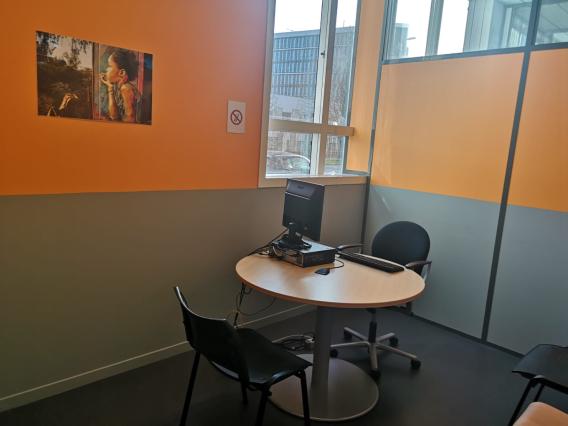The statistics mission
Ofpra's studies and statistics mission was created in 1992. Two people currently work in it, under the supervision of the general secretariat.
Its purpose
Its primary purpose is to relay all of the information necessary for running Ofpra by :
- compiling all figures on asylum in France, for which it is regarded to be the authoritative statistical source ;
- identifying and creating relevant indicators ;
- collecting, organising and streamlining information ;
- updating management charts for detailed statistical monitoring of activity for the purposes of forecast management.

It makes a very active contribution to drawing up the annual report; it produces a monthly analysis of the past month's activity and helps to write the report on foreigners in France for Parliament.
Finally, the studies and statistics mission collaborates and exchanges information with Ofpra's institutional partners and counterparts, all the while ensuring that data remains confidential with a view to protecting the individuals concerned. It is involved in the European programme for harmonising statistics on asylum.
Methodological clarifications for a good understanding of Ofpra's statistics :
Protection applications
For a good understanding of Ofpra's statistics, it should be noted that (since 1989) Ofpra has been counting all recorded asylum applications on the basis of the following principle :
| one file = 1 person = 1 identity = one asylum application |
Following a first request, the same person can then file one or more re-examinations of their request or ask to reopen their file if it has been closed.
| Ofpra application = first international protection application + re-examinations application + reopening of the case application |
The term “request for protection” includes both the request for asylum and the request for stateless person status.
Until May 2002, this only concerned adults and
unaccompanied minors
; since then, accompanied minors have also been attributed a personal file number, attached to the that of his/her parent.
Unless specified otherwise, the figures provided for "applications" generally correspond to first-time asylum applications.
The decisions
The statistics bearing on "decisions" usually refer solely to cases where protection is granted (CR = conventional protection & PS =
subsidiary protection
) and rejections (RJ), following examination of a first-time application, a re-consideration application or an
informal appeal
, without distinction. Since 2016, decisions to close an application have also been included.
| Ofpra decisions = protection granted + rejections + closed decisions |
Several decisions can be issued in succession on the same file. Decisions issued during a given year do not necessarily and solely correspond to applications submitted the same year, but can include applications submitted earlier.
Until 2000,
CNDA
annulments were included in Ofpra's figures. Since the publication of the 2000 annual report, the distinction between protection granted by Ofpra and protection granted by the CNDA has been clearly drawn.
The overall admission rate, which includes annulments issued during the year, is now also presented alongside Ofpra's admission rate.
As such, Ofpra publishes several admission rates:
- the overall admission rate, which was the only figure available until 2000, factors in the total number of Ofpra’s admissions and admissions following an annulment by the CNDA,
- Ofpra's protection rate, distinguished in statistical terms since 2001, which only factors in positive decisions issued by Ofpra,
- the applications-based admission rate, published during the report on asylum applications submitted in year "n". The rate of protection indicated is therefore relative to the applications recorded during the year, unlike the first two rates which refer to the decisions issued during the year. This implies that all applications have been examined and have been subject to a decision at first instance, on appeal or even appeal en cassation in some instances, and that all remedy channels, whatever they may be, have been exhausted. Ofpra publishes these reports at n+3 or n+4. The report for 2014 was published in the second semester of 2018.
Recognised refugees
Until 31 December 2003, their number corresponded to the number of valid
refugee
certificates on 31 December of a given year, which means it was only an estimation. This is because, on the one hand, Ofpra was not systematically informed of outflows from refugee status (deaths, naturalisations, permanent departures, etc.) and, on the other, refugee certificates whose renewal was requested with undue delay could not be taken into account.
The refugee certificate was abolished on 1 January 2004, and the calculation method has since been changed.
Now, it is necessary to add to the total of recognised refugees on 31 December 2003 the people having been newly placed under Ofpra's protection each year, and to deduct the annual known outflows (relinquishments, cessations, naturalisations and deaths).
The figures presented should still be viewed solely as estimations, since the outflows are not systematically brought to Ofpra's attention.
Until 2020, the number of recognised refugees is calculted by including minors.
Notes on counting minors :
Until May 2002, this only concerned adults and unaccompanied minors ; since then, accompanied minors have also been attributed a personal file number, attached to the that of his/her parent. This first step made it possible to estimate the number of minors accompanying their parents in their application for protection before the Ofpra.
Since 2020, in order to take into account the provisions of article L. 521-3 of the Ceseda relating to family asylum applications (law no. 2018-778 of September 10, 2018), the data published on applications and decisions systematically integrate all data relating to minors. Indeed, minors, whether they are accompanying, joining or born after their parents' asylum application, now file an asylum application in their own name, via their legal representatives. Their asylum applications are therefore individualized as soon as they are registered in GUDA .
